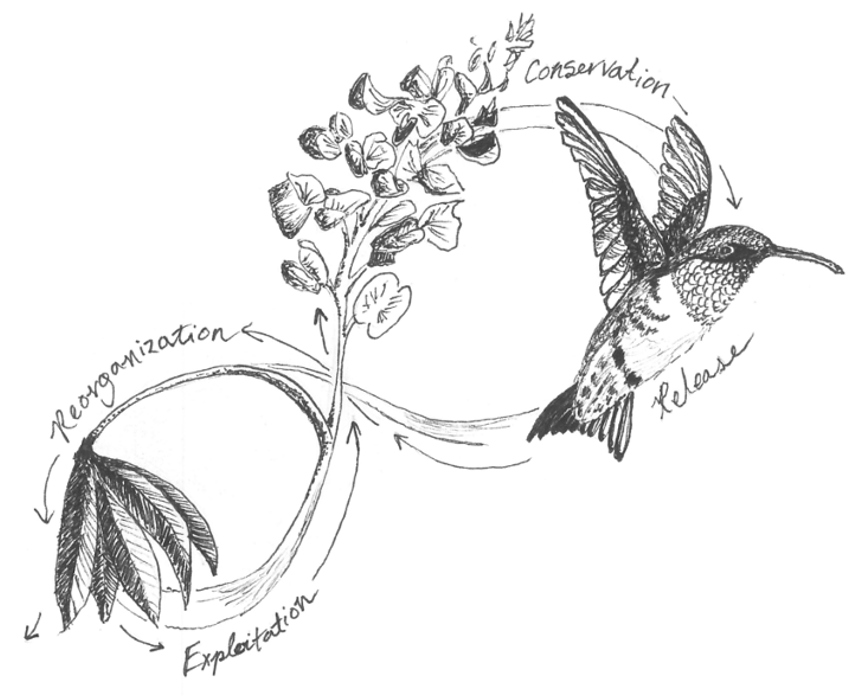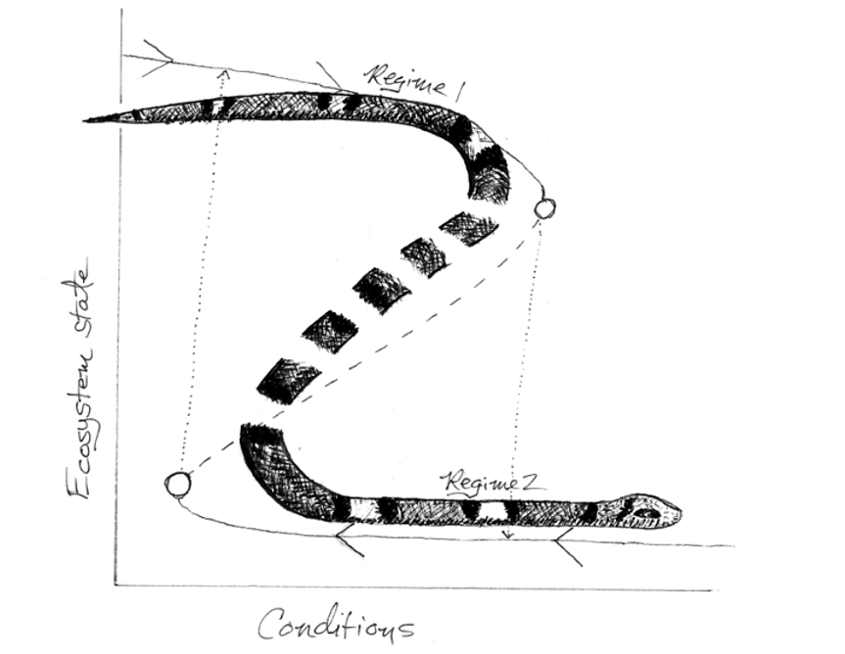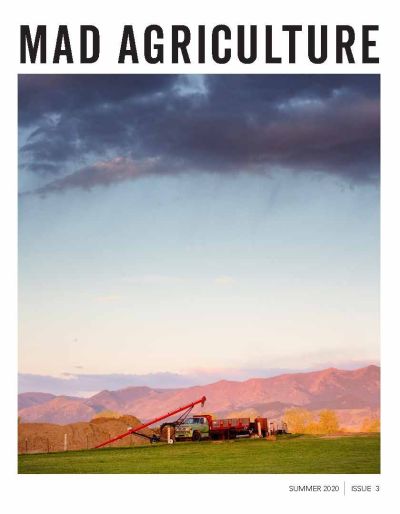
The Mad Agriculture Journal
A Primer on Resilience in Ecology and Agriculture
Published on
June 01, 2020
Written by
Caity Peterson
Photos by
Jordan Perkins
Illustrations by
Caity Peterson
Lee esto en español.
First thing first: as a new voice in the Mad Ag Journal, let me introduce myself. I arrived in the Front Range almost a year ago as I write this. Before that I was in California, studying at UC Davis for my PhD, and before that in Cali, Colombia, where I was an ag development researcher regularly dispatched to Ghana, Tanzania, and elsewhere in the global tropics to study and report on adaptation to climate change in smallholder agriculture. And before that, in Florida, where I grew up and where it all started on my family’s farm, where we raised horses, and my mother a garden, my brothers and I the odd 4-H animal, where by night there were coyotes that laughed in the back pasture and by day snapping turtles that lounged in the pond down in the old oak hollow. And before that, and before that…
As a grad student back in California, I chose to study ecology rather than the agronomy and horticulture tracks that UC Davis is known for. In explaining this decision to colleagues and confused relatives, I always resorted to the same justification: I wanted to be an ecologist that studies agriculture, rather than an agronomist that dabbles in ecology.
It might seem like a trivial distinction, but for me it colors the way I look at everything – the farm as an ecosystem rather than a machine, and agriculture as a landscape of shifting hierarchies and complex interactions among soil, water, air, and organisms.
The science of ecology also appeals to me because it is young and messy and changing fast. The theories I learned in college only ten years ago are already all but obsolete. Furthermore, there is little that can be learned in ecology without prolonged, concentrated stints of observation in the field. The early heroes of ecological thought were adventurers and explorers: Humboldt on Mt. Chimborazo! Darwin in the Galapagos! E.O. Wilson in New Guinea! Even today, there are few fully committed armchair ecologists. The discipline still needs to prove itself. That means going outside and getting hungry, tired, and dirty and, if you’re me, sunburned, in pursuit of your science. And I like that.
With that little soliloquy out of my system, it’s time we turn to my favorite concept and working theory in ecology: resilience. No, not #resilience. It’s a nice hashtag, I admit; a perfect trendy word to lift spirits in times of uncertainty, and especially now that we’re all tired of using #sustainability. But I want to talk about resilience as I know it, which is as a much deeper concept rooted in ecological thought going back, well, a few decades at least.
Studying plant ecology as an undergrad in Florida, I learned that ecosystems at their peak are in equilibrium. That ecosystems only change inasmuch as they are approaching their climax state, from one step in the chain of succession to the next. Ecologists now think differently. Systems are not static, but constantly in flux or non-equilibrium. It’s the stable ecosystems that are the outliers. “Dynamic equilibrium” is the sexy name ecologists chose for this property. Hashtag that. And importantly, there is no one possible state for a given ecosystem, but many such. Many alternative realities, if you like.
There are lots of cool graphs with lines on them to describe this concept of ecosystems. There’s this one, for example:

It’s called “the adaptive cycle.” Nice, isn’t it? It show how ecosystem cycle through continuous stages of change, from exploitation (growing rapidly and consuming resources), to conservation (staying the same for a while), release (a sudden change) and reorganization, when the components of the system rearrange themselves into another system that doesn’t always look the same as the original.
Or there’s this one, another of my favorites:

“Hysteresis.” It’s showing how a system in one state can rapidly and non-linearly change into another state, and how you can’t always follow the same path to “go back” to the original state. The state of a system, in other words, depends on its history. Does that sound relevant to cropland management? How about ranching, or forestry for that matter? Think of it this way. An arid grassland can only be grazed for so long, by so many cattle, before it turns into a desert. When it reaches that tipping point, is it as simple as removing the cattle and the grassland will be restored? Probably not. Corrective management forces will have to be applied that are disproportionate to the grazing forces that caused the flip in the first place. And it might take much longer to get back to that grassland state than it did to flip from grassland to desert. That’s hysteresis.
But we’re getting off topic. There’s this other little line drawing that gets at the heart of resilience. It’s called a ball-and-cup diagram, or “roll-y ball” diagram, or – okay I’m still soliciting better names for this thing. I told you, ecology is a new science. It might have an unsatisfactory name, but it tells us a lot of things in just a few strokes.
Firstly, resilience is a property of systems. Any system – agricultural, marine, urban, social, digital – can have this property to varying degrees. It reflects the robustness of the system’s current reality. Things seem pretty good (or pretty bad) right now, but are they likely to stay that way? Or could a little push tip it over into another state?
Secondly, a system is a whole landscape of these alternate possibilities, looking much like one of those maze games I used to play as a kid. The one where you roll a ball around in its plastic case, trying to get it through the maze while avoiding the holes and dead ends. The holes, or basins, are different possible states that the system might fall into, depending on how far and in what direction you tilt the maze.
Finally, the shape of the basin represents the resilience of the system’s current state: deep and narrow means highly resilient. A lot of effort, many stacked disturbances and/or chronic stressors would be required to push it up and over the slope. The shallow, wide cup on the other hand – one little tap and it’s a whole different ball game. One hailstorm. One drought year. One pass too many of the plow.

The interesting thing for those who manage ecological systems, including farmers, is that the shape of that basin can change. The actions you take on your farm, the structures and interactions you foster, can make your basin shallower or deeper. Maybe you have a bad egg of a field, chronically low yielding and with unkind soils. Then you work to make that basin shallower so you can eventually bump the field into a more wholesome, healthier state. And conversely, in a system that’s working in your favor, you can build depth to the basin and do what you can to make sure that even a big bump won’t stop it from functioning in the way it has been. You can build in self-sufficiency, redundancy, diversity, adaptability – and so foster resilience. Like a line drawing. One line alone is merely two dimensional. But the more lines you add, the more possibilities emerge: the possibility of depth, of texture, of shading.
The old way of farming would have you act on the ball itself, throwing inputs and horsepower at a problem to coerce a system into producing the desired outcome. The new way looks at the shape of the basin itself, strategically tugging the strings to reshape the landscape of equilibria that underlies the farm ecosystem. The former casts the farmer as Sisyphus. The latter as the puppet master.
The ecologist C.S. Holling first put the name “resilience” to the property that describes a system’s ability to continue functioning under stress. That was in 1982, about 120 years after the Origin of Species was published, and almost 300 years after Newton described the laws of motion. Ecology is slick with newness, with regeneration, with emergent knowledge of the living earth. Ecology may be young, but we have been building towards this understanding of resilience for years and years. The excitement around the term and what it means for the way we build our newest realities is no passing trend. It is less a new idea than a re-distillation of much that we who observe the world closely – we farmers, we ecologists – already suspected. It is a deep, high-walled valley of thought. But, more importantly, it is still under construction. How to measure it? How to put theory into practice? What to call it, even? We’re on that journey together, right now; it’s time to build it.
